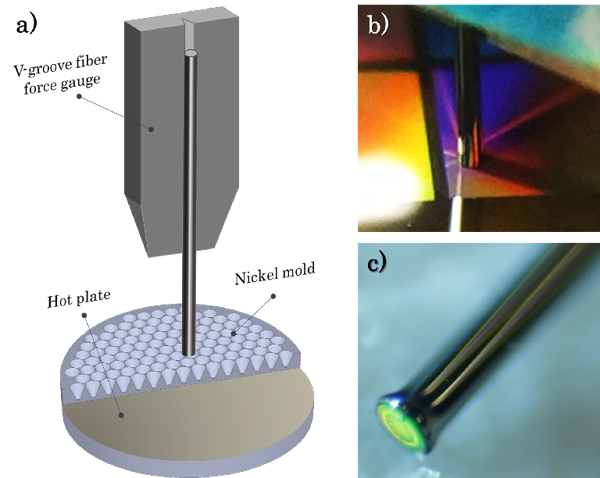Thermal nanoimprint lithography, or nanoimprinting in short, is the process by which nano- and microscopic structures are transferred onto a material by heating it up to a specific temperature, such that it becomes malleable and can be molded into a desired shape. The technique has proven particularly useful for chalcogenide glasses due their low glass transition temperatures (e.g. 185 ºC), that allow for structuring of the glasses at temperatures that are easily obtained by conventional heaters. For this reason, thermal nanoimprinting has been applied in the fabrication of various photonic devices, including planar waveguides, diffraction gratings, and ring resonators.
Unfortunately, due to the high refractive indices of chalcogenide glasses, transmission of light in chalcogenide waveguides and optical fibers are limited by strong Fresnel reflections at the interfaces with air or other low index materials. Several methods have been proposed to obtain anti-reflective (AR) properties, including Brewster angle connectors, thin-film coatings, and nanoimprinting of moth-eye structures. The Brewster angle for typical As40Se60 at. % chalcogenide glass is around 70 degrees from 2-10 µm, which although inconvenient is relatively simple to implement. However, the AR effect works only for linearly p-polarized light, making it sensitive to polarization fluctuations and reducing its effectiveness for circular or unpolarized light sources.
Thin film deposition on the fiber end faces has been demonstrated to improve the transmission of chalcogenide fibers, but tends to reduce the damage threshold of the fiber due to differences in thermo-mechanical properties between the deposited coating material and the optical fiber. This causes the coating to crack and delaminate as the fiber end face heats up during use. Furthermore, single layer coatings can only provide AR properties over a relatively narrow wavelength region of a few hundred nanometers, and the peak wavelength is very sensitive to the layer thickness. Multilayer coatings are therefore needed to extend the bandwidth, which increases the complexity and reduce the thermo-mechanical robustness.

(a) Illustration of the thermal nanoimprinting principle. (b), (c) Photograph of the fiber (b) during and (c) after imprinting. The different colors are due to the angle and wavelength dependent reflection of the nanostructures.
In contrast, so-called moth-eye AR structures can be directly imprinted on the end face of optical fibers to achieve broadband-, polarization-independent-, and high throughput transmission without the risk of damage due to cracks and delamination. In a previous report, an increase in transmission over a broad bandwidth was achieved in single-material chalcogenide photonic crystal fiber (PCF) via nanoimprinting. However, traditional step-index fibers (SIF) have the additional challenge of having different core and cladding glasses, each with its own thermo-mechanical properties. Reports from the literature on nanoimprinting of AR structures onto SIF end faces have so far been limited to large-core multi-mode fibers of the sulphide-glass type, with small variation between core and cladding glass compositions. Consequently, the effect of different thermo-mechanical properties in highly disparate glasses and small-core SIFs has, to our knowledge, not been explored until now.
Christian R. Petersen and co-workers from Technical University of Denmark, Department of Photonics Engineering and the National Centre for Nanofabrication and Characterization, experimentally tested the dynamics of nanoimprinting SIFs with different core/cladding glass compositions, and therefore different thermo-mechanical properties. The work was performed in collaboration with the Mid-Infrared Photonics group at the George Green Institute for Electromagnetics Research, Nottingham University, United Kingdom, and published in Chinese Optics Letter, Volume 19, Issue 3, 2021 (C. R. Petersen, et. al., Thermo-mechanical dynamics of nanoimprinting anti-reflective structures onto small-core mid-IR chalcogenide fibers [Invited]). The study highlights some of the challenges of nanoimprinting on small-core SIFs, in particular the contraction of the core glass during imprinting, and propose a method for achieving good imprints and greatly improved transmission without excessive deformation of the fiber tip. The conclusion of this investigation is, that nanoimprinting is a versatile and practical method for achieving high transmission in both small-core and large-core chalcogenide SIFs, that can be scaled to industrial-scale fabrication without the need for cleanroom deposition facilities.
The research team hints at a future application of the technology within end face preparation of multi-material fibers, composed of different polymers, glasses, and metals. Such fibers are very difficult to polish due to the different hardness of the materials, and would therefore benefit greatly from thermal nanoimprinting. Here, the researchers present a proof-of-concept result with imprinting the AR-structure on a polymer/chalcogenide multi-material fiber.


